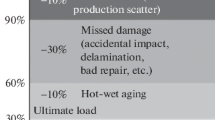Abstract
The use of composite materials in civil aviation is today certainly widespread, but sometimes this not implies that the final product is obtained exploiting the full potential of this kind of materials. The complexity of the composite material systems, the difficult repeatability of the products and their inspection, the high sensitivity to damages and defects, more severe certification constraints, often can discourage the use of these materials, especially for small aircrafts. New design approaches are necessary to overcome the current design methods applied by the aircraft manufactures, which often generate oversized and expensive structures respect to the expected ones. On the base of some results and experiences accrued, and in progress, in some projects coordinated by CIRA and funded by Italian Aerospace Research Programme, this work summarises advanced and new design approaches aimed at reducing the conservativisms of the current design. New protocols and paradigms are finalized to an improved and less time consuming building block approach, by means of the use of numerical procedures and more effective tests and tools for the material characterisation, also considering the use of structural health monitoring systems. Sensors/actuators, applied in the last decades for maintenance purpose, are now also under investigation to improve the design methods. In this framework, the use of general-purpose software, in-house developed codes and dedicated testing approaches, have become part of an improved new building block and structural sizing approach, for an efficient design of the next generation composite structures.

















Similar content being viewed by others
References
Baaran J (2009) EASA research project: study on visual inspection of composite structures
Borrelli R, Di Caprio F, Mercurio U, Romano F (2013) Assessment of progressive failure analysis capabilities of commercial FE codes. Int J Struct Integr 4(3):300–320. https://doi.org/10.1108/IJSI-06-2012-0017
Borrelli R, Franchitti S, Di Caprio F, Romano F, Mercurio U (2015) A numerical procedure for the virtual compression after impact analysis. Adv Compos Lett 24(4):57–67
De Fenza A, Sorrentino A, Vitiello P (2015) Application of artificial neural networks and probability ellipse methods for damage detection using lamb waves. J Compos Struct 133:390–403
EASA (2010) Composite aircraft structures. AMC 20-29
Hachenberg D (2002) The role of advanced numerical methods in the design and certification of future composite aircraft structures. In: 5th World congress on computational mechanics, WCCM V, Vienna
Hahn HT, Tsai SW (1983) On the behavior of composite laminates after initial failures. Astronaut Aeronaut 21:58–62
Hashin Z (1980) Failure criteria for unidirectional fiber composites. J Appl Mech 47:329–334
Herszberg I, Bannister MK et al (2007) Structural health monitoring for advanced composite structures. In: 16th international conference on composite materials, Kyoto
Kassapoglou C (2010) Design and analysis of composite structures with applications to aerospace structures. Wiley, London
Knight NF Jr, Rankin CC, Brogan FA (2002) STAGS computational procedure for progressive failure analysis of laminated composite structures. Int J Non-Linear Mech 37:833–849
Lin WP, Hu HT (2002) Nonlinear analysis of fiber-reinforced composite laminates subjected to uniaxial tensile load. J Compos Mater 36:1429–1450
Murray Y, Schwer L (1990) Implementation and verification of fiber-composite damage models. Fail criteria and analysis in dyn response. ASME AMD 107:21–30
Nahas MN (1986) Survey of failure and post-failure theories of laminated fiber-reinforced composites. J Compos Technol Res 8(4):138–153
Orifici AC, de Zarate Alberdi IO et al (2008) Compression and post-buckling damage growth and collapse analysis of flat composite stiffened panels. Compos Sci Technol 68:3150–3160
Petit PH, Waddoups ME (1969) A method of predicting the nonlinear behavior of laminated composites. J Compos Mater 3:2–19
Romano F (2015) Design of composite stiffened panels by new design criteria and progressive failure analysis. Ph.D. thesis, Aerospace Engineering, University of Naples Federico II, Naples
Romano F, Di Caprio F, Auriemma B, Mercurio U (2015) Numerical investigation on the failure phenomena of stiffened composite panels in post-buckling regime with discrete damages. J Eng Fail Anal 56:116–130. https://doi.org/10.1016/j.engfailanal.2015.03.012
Romano F, Di Caprio F, Mercurio U (2016) Compression after impact analysis of composite panels and equivalent hole method. J Proc Eng 167C:182–189
Schuecker C, Pettermann HE (2008) Constitutive ply damage modeling, FEM implementation, and analyses of laminated structures. Comput Struct 86:908–918
Sorrentino A, De Fenza A (2016) Improved elliptical triangulation method for damage detection in composite material structures. Pro Inst Mech Eng Part C J Mech Eng Sci. https://doi.org/10.1177/0954406216682053
Sorrentino A, De Fenza A (2017) Damage detection in complex composite material structures by using elliptical triangulation method. In: 11th IWSHM, international workshop on structural health monitoring, Stanford
Acknowledgements
The authors thank Francesco Di Caprio, researcher at CIRA, and Mauro Linari, senior project manager at MSC Software Company, for their support to the activity of finite element analysis, and Professor Antonio Langella of University of Naples Federico II, for the execution of the mechanical tests.
Author information
Authors and Affiliations
Corresponding author
Ethics declarations
Conflict of interest
On behalf of all authors, the corresponding author states that there is no conflict of interest.
Rights and permissions
About this article
Cite this article
Romano, F., Sorrentino, A., Pellone, L. et al. New design paradigms and approaches for aircraft composite structures. Multiscale and Multidiscip. Model. Exp. and Des. 2, 75–87 (2019). https://doi.org/10.1007/s41939-018-0034-8
Received:
Accepted:
Published:
Issue Date:
DOI: https://doi.org/10.1007/s41939-018-0034-8




